Lymphoedema secondary to breast cancer is one of the most unfortunate outcomes, which is not amenable to permanent treatment. Physicians, palliative care providers, and therapists can only offer management for this condition. Women treated for breast cancer are facing a lifetime risk of developing lymphoedema, which occurs in up to 40% of this population and negatively affects breast cancer survivors’ quality of life.[1] Lymphoedema, secondary to breast cancer in the ipsilateral upper extremity, has been described in the literature. Still, here we would like to report the management of lymphoedema and lymphorrhoea in the breast itself, done by wrap-around bandaging and active pharmacological agents in the palliative care unit of a tertiary care hospital.
CASE REPORTA 56-year-old female who was under evaluation for right carcinoma breast, post fine-needle aspiration cytology (FNAC) reported to the palliative care unit with the complaint of right breast enlargement with non-healing wound developed at the site of FNAC and weeping of skin surrounding the wound and the breast throughout the day. As the patient was under evaluation phase for the lesion in her breast at the time of presentation in the palliative clinic, she primarily complained of disturbed sleep because of the continuous soaking of her clothes. However, she was not suffering from any kind of pain. She also has some retraction of the concerned breast and complained of heaviness with drag down feel. She resorted to breast support, but due to her enlarged breast, the market-bought support was not adequate for her condition. The situation was embarrassing for the patient as she needed to continuously change her clothes due to soakage, sometimes as much as 6–8 times a day. The wound, because of the breast condition, was also not showing any improvement. The quality of life was degrading day by day because of the condition as well as to her concern; even though she was conveying her issues to physicians, the larger interest was shown to establish her diagnosis, and the very immediate troubling problem was shown little or no concern. On inspection, the wound was 5 × 6 cm in greatest dimension with necrotic margins and pale slough present at the base with almost no granulation tissue, with two small satellite wounds in the vicinity. No foul smell or active discharge was present in the wound. The weeping of fluids in the surrounding skin of the wound was associated with induration, and maceration beneath the breast was also seen [Figure 1]. There was a generalised erythema all over the concerned breast.
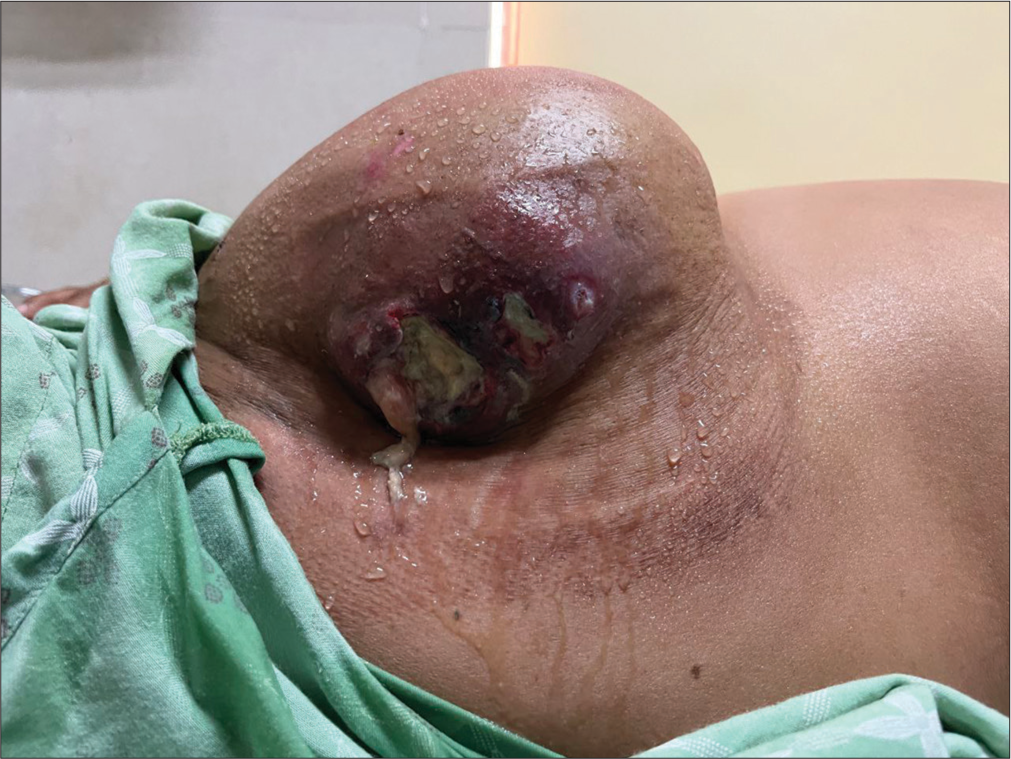
Export to PPT
THERAPEUTIC INTERVENTIONManagement of the case was done keeping two things in mind-immediate relief from lymphorrhoea and associated skin damage and reduction of lymphoedema.
As she was not using inadequate support, active crepe 6-inch bandaging was done with a pre-wrap of soft roll to soak up the lymph fluid. The breast was wrapped in such a way that it took the support of the ipsilateral shoulder in an L-shaped loop, and then, the other breast was looped along in a tube fashion [Figure 2]. This wrap was done over the dressing of the wound [Figure 3]. This was done by the palliative care physician in the clinic itself and simultaneously taught the attendant to continue the same at home. The crepe bandage was changed every two hours to achieve constant compression. Simultaneously, she was given furosemide for ten days (about one and a half weeks) in a dose of 40 mg/day to achieve a controlled whole-body water excretion along with proteolytic enzymes preparation of trypsin, chymotrypsin, and bromelain and benzopyrone to achieve hydrolysation of tissue protein while activating the lymph transport route, promoting its absorption.[2] Furthermore, her upper limb mobility exercises were regularised, and low sodium-rich food was promoted to prevent any further water retention.
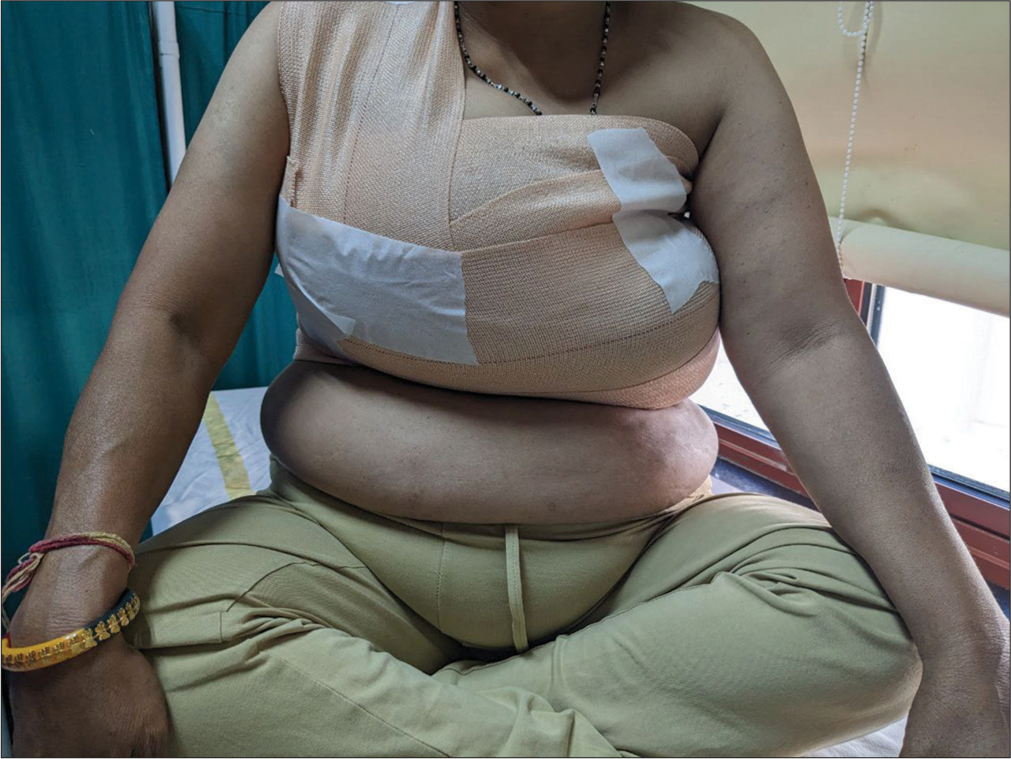
Export to PPT
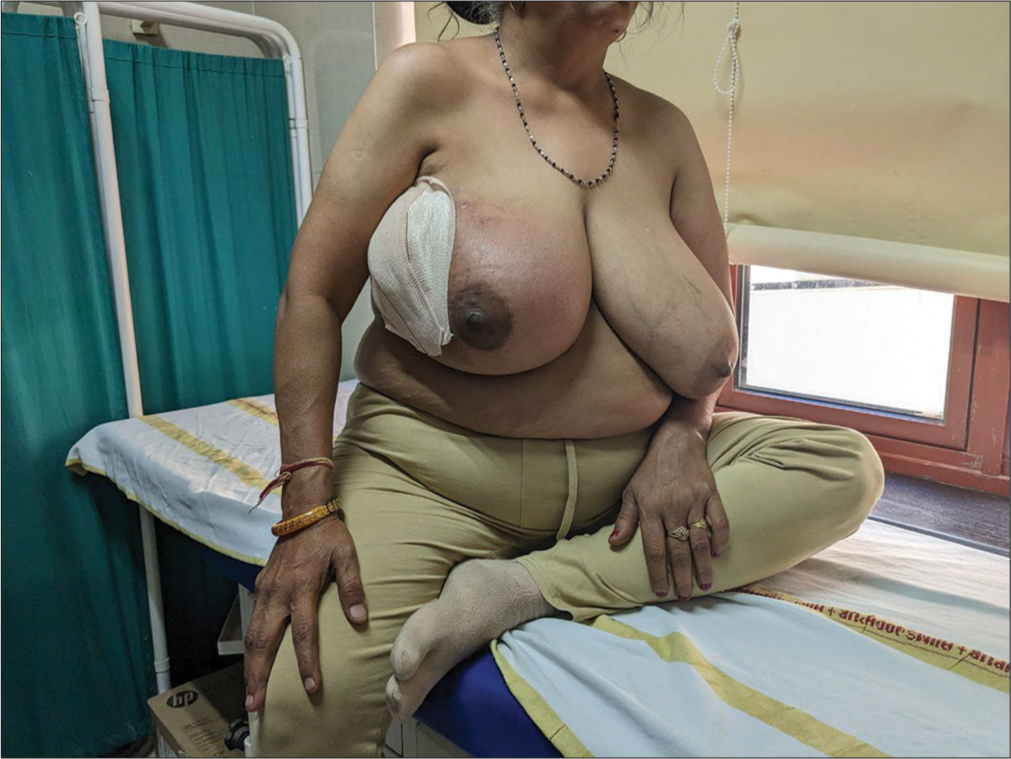
Export to PPT
FOLLOW-UP AND OUTCOMESAfter two weeks, her lymphorrhoea resolved, and the soakage of clothes stopped. Skin induration was also significantly reduced [Figure 4]. This eventually helped in the reduction of her wound size to 4.2 × 5.1 cm in greatest dimensions, along with significant reductions in the satellite wounds [Figure 5]. Her outlook and quality of life also improved with holistic management. Before the intervention, the patient was extremely apprehensive about getting into the course for her treatment as the present condition was distressing for her, and she was worried that even though she might have to undergo radical mastectomy and post-surgery, her condition could deteriorate. There was a culmination of one thought after another regarding her prognosis and quality of life. At the time of the presentation, she uttered, ‘With this situation, I do not want to continue my life anymore.’
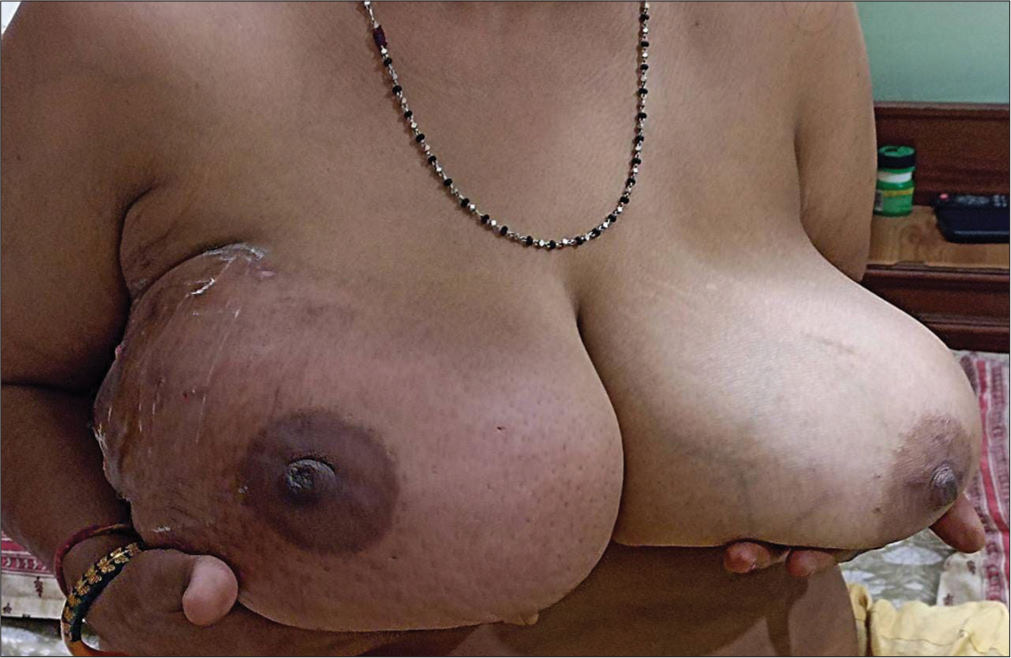
Export to PPT
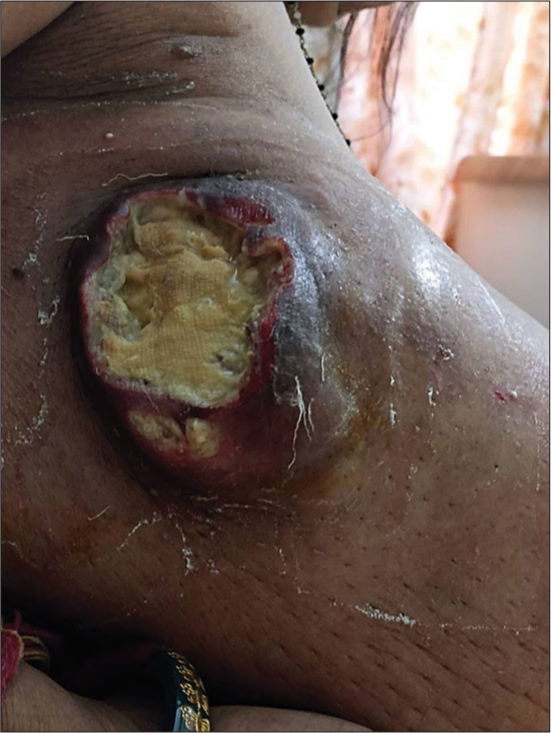
Export to PPT
At follow-up, she was significantly optimistic about the course of treatment, and there was a sense of relief of being heard. This positive impact of satisfaction is reflected in her thoughts to comply with further treatment.
With this care and intervention, we were also able to counsel her that she might develop lymphoedema in her hand if she undergoes a radical mastectomy, a care plan was formulated, and important preventive measures were laid.
DISCUSSIONBreast cancer survivors with lymphoedema in the ipsilateral upper extremity report experiencing multiple symptoms, including swelling, heaviness, tightness, firmness, pain/aching/ soreness, numbness, tingling, stiffness, limb fatigue, limb weakness and impaired limb mobility of shoulder, arm, elbow, wrist, and fingers.[3-6] However, lymphoedema in the breast with lymphorrhoea is an uncommon condition to deal with.
In this case, pain was not an issue; the concern of the patient was easily overlooked, and no rehabilitative measures were taken to improve the immediate quality of life while she was evaluated for the breast lesion. The biggest challenge was to proceed with not much literature available on the management of lymphoedema with lymphorrhoea in the breast; ergo, the basic concepts of bandaging along with pharmacological agents were resorted to.
The compression bandaging was done with a crepe bandage and soft roll only as it was easily available and could be afforded by the patient. The bandaging was done in a spiral way in view with the provision of added support taken from the ipsilateral shoulder as depicted in the image.[3]
CHALLENGES FACEDThe biggest challenge was to proceed with not much literature available on the management of lymphoedema with lymphorrhoea in the breast; hence, the basic concepts of bandaging along with pharmacological agents were done.
NEW LEARNINGSEvery managed case of lymphoedema is unique to the patient’s needs and is tailored accordingly.
Locally available resources should be used to enhance compliance with the treatment and results.
Identifying the problem areas and listening to patients themselves provide clues to tailor treatment.
Counselling patients, even in cases of non-treatable conditions, helps them to participate in treatment better with the expectation of a realistic goal of managing the condition.
CONCLUSIONThe use of compression bandages was previously reported to keep the functional status of the bandaged upper extremity and to reduce swelling volume in the stage of treatment for breast cancer-related lymphoedema.[7] The passive lymphatic flow is facilitated by the pressure between the muscles and the bandage. The variable pressure across the bandaged skin when the muscle contracts is identical to the effect of massage. It is encouraged to wear the bandage as long as possible, including at night.[8] Furthermore, the bandage maintains the achieved volume reduction in the limb or concerned organ.
Here with knowledge available for bandaging techniques (Bandaging methods: [a] spiral method bandaging and [b] spica method bandaging),[9] we utilised the available resources and helped the patient to alleviate the suffering and improve the quality of life. The inferior quality of existing trials on pharmacological agents makes it impossible to draw conclusions about the effectiveness of the pharmacological approach for lymphoedema amongst breast cancer survivors[10]. Still, the use of the drugs, in this case, hastened the achievement of the desired goal.
Every managed case of lymphoedema is unique to the patient’s need and is tailored accordingly. Locally available resources should be used to enhance compliance with the treatment and results.
留言 (0)